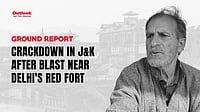ONE fine morning, beret fashionably angled, heavy lenses sparkling, Le Corbusier drove into Kipling's Punjab to select a site for his masterpiece. On a flat dusty plain below the Himalayas, he planted a flag. And while the band played the anthems of India and France, while hastily rounded up Brahmins performed puja and recited mantras, Corbu was at work, thinking. He'd do the city plan and design the government buildings of democracy, his local associates would do the mundane buildings: housing for the masses, schools and other trivia. Yes, that's it. He folded his sketch pad and flew back to Paris.
Corbusier was an artist, a creator. He worked alone, tirelessly in his Paris studio. He worked at a feverish pace, producing paintings, drawings for buildings and ideas for cities, at times in a single day. His output equalled Picasso's and was equally varied. Out of such a mind, the Chandigarh plan emerged. The work of an artist, it was to be as inflexible, authoritative and perfect as the man who produced it.
Besides, independence was a heady feeling and Nehru's great leap into modernism necessitated equally monumental and irrational leaps in architecture. Chandigarh was built when planners attached great value to width of the road, yawning concrete plazas and Cartesian grids, separate residential and commercial enclaves and the private house. So the organic and neighbourhood growth patterns of the traditional towns were cast aside for a pre-planned geometric order.
Democracy had come to India, and Chandigarh, according to Nehru, was to give it physical expression. It was independent India's first planned city, and promised a different sort of life. It was to supply all its inhabitants equal access to civic amenities, a social atmosphere of equality; today there's no Indian city with a sharper, more clearly delineated distinction in class and economic status. The city was meant to create a happy mix of residential and commercial areas. Yet the strict zoning produced the opposite. Commerce, like housing, has its sectors. The great shadowless plazas, wide roads, are the domain of the car-owning elite. The air is indeed clean and in the distant park there is even a hint of green. For some there is great joy in driving in straight lines, unhindered by the bullock cart. But what more?
Corbusier is now dead, but Chandigarh, his Indian legacy, is a living city. Architects over the world are, on the city's 50th anniversary, celebrating the city he created as an artistic achievement. But amid the toasts to a great master, people are also asking: Is the Cartesian grid the only manifestation of freedom? Being able to drive in straight lines, is that an ideal of democracy? There's no denying Corbusier's contribution to Indian architecture. There's also no denying Indian architecture's contribution to Corbusier. The buildings he created at the Capital Complex - the Assembly, the Hall of Justice and the Secretariatóare undeniably brilliant works of imagination. But whether they sprang from an Indian ethos, or the complexes of history, or whether their Indianness developed out of their site or construction materials, or how they weathered India's climate, is best left to architectural academicians. The city is another matter.
The sociology and culture of Indian habitation overwhelm any artistic idea - however grand its scale. Consequently, for the vast majority of its less privileged citizens, Chandigarh, the idea, held little promise. Pavement dwelling, over-crowding, shanty towns - living components of India's cities - were denied by stringent laws.But the pressures on planning in India were too great to be brushed aside by zoning laws. Before Corbusier could experience his city as a completed vision, encroachments marred his landscape. The cheap labour force had been wonderful on building sites, but once complete, the city scheme had no place for them. They were forced to live beyond the planned sectors; as were the dhaba wala, the mechanic, the small shop owner. The transformation was inevitable - in Chandigarh, as in other cities, two parallel cities coexist: India and Bharat.
Erroneously, for Le Corbusier and for Nehru, the idea of a modern city grew from a static self-absorbed vision. Against the statistical background of ceaseless migrations, housing problems, political unrest - an evaluation of the city's artistic merits seem hazy, misplaced, uncertain. That two divergent cities developed contiguously seems to worry architects less than the apparent failure to retain Le Corbusier's original architecture.
THE making of a city - unlike that of a painting, a sculpture or a single building - is a difficult social and cultural phenomenon. The coming together of large numbers of people, skills and disciplines is itself an achievement. It's the planning principles of Chandigarh that one questions today, and the fact that the same principles - 50 years after its conception - still govern its growth. Living cities change; monuments don't. The fact that the ceaseless thrust of migrations have not, for these 50 years, influenced the original Corbusian scheme is in direct contrast to the changing cultures of Delhi, which, for good or bad, in the same period, has radically altered the city's urbanity and architecture.
It is ironic that our pluralistic, intensely adaptive culture should preserve a foreign city in its most foreign state. Were Corbusier alive, it's unlikely he'd approve. Perhaps like his housing projects at Pessac, France, which underwent perpetual alteration, Corbusier would have preferred a city changing with its inhabitants. A stagnant city is hardly a memorial to a man, himself resilient and continually changing.
What is 50 years in the life of a city? Perhaps 100 years later, Chandigarh will be like any other Indian city. And as Charles Correa said, Corbusier will be acknowledged as a great Indian architect.






















